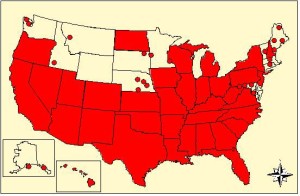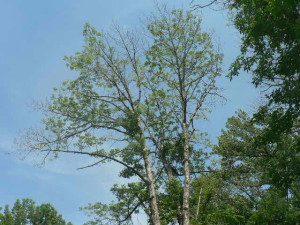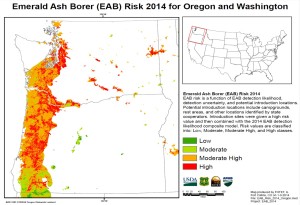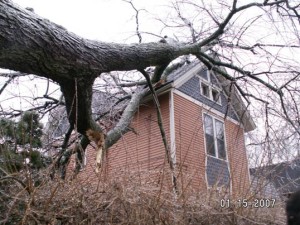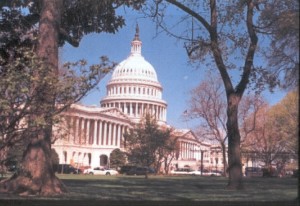The Public Lands Subcommittee of the Senate Committee on Energy and Natural Resources held an oversight hearing on invasive species management on federal lands on April 28, 2016. This hearing is the result of lobbying effort by the Healthy Habitats Coalition, which drafted the initial bill and has worked for its passage for several years. One specific aim was to gather comments on S. 2240.
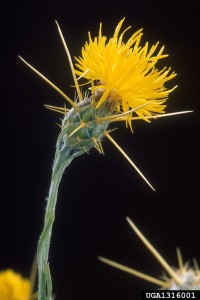 yellow start thistle photo by Peggy Greb, USDA ARS Bugwood # 1316001
yellow start thistle photo by Peggy Greb, USDA ARS Bugwood # 1316001
The bill would, inter alia, require land-managing agencies to allocate their invasive species funds according to the following formula: 75% for on-the-ground activity; 15% for combined research and outreach; 10% or less for administrative costs. Priorities for federal agencies’ invasive species efforts would be set by state governors. The bill would also exempt some invasive species control programs from analysis under the National Environmental Policy Act (NEPA).
In December 2015 I posted a blog about an earlier hearing on the bill (H.R. 1485) held by the House Oversight Committee.
WHO WAS THERE?
Witnesses represented the USDA Forest Service, USDI Bureau of Land Management, the Wyoming Department of Agriculture, Healthy Habitats Coalition, and I, representing the Center for Invasive Species Prevention and Natural Areas Association. The witnesses’ written testimony and hearing video are archived here
Senators at the hearing were Chairman Barasso (WY), Franken (MN), and Hirono (HI). Senators Risch (ID), Hoeven (ND), and Gardner (CO) attended briefly. About 13 Congressional staffers were there, along with an audience of 15-20 and two from the press.
In their introductions, all senators spoke about the economic damage caused by invasive species Chairman Barasso said his bill – S. 2240 — is intended to fix western complaints about the ineffectiveness of federal agencies’ efforts. Senators Franken and Hirono agreed on the need for new tools and strategies and better coordination among actors. However, they expressed concern about some components of the bill.
At the end of the day …
The Healthy Habitats Coalition and the Wyoming Department of Agriculture support the bill. The USFS supported the bill’s goals and emphasis on collaboration but had some concerns. BLM praised changes made from earlier versions of the bill, hopes additional clarifications will be made, and explicitly opposed the categorical exclusion from NEPA. CISP and NAA (I) opposed the bill and suggested that the Senators take other actions to strengthen federal invasive species programs.
Will the bill move forward? I think action is unlikely … It is a shame that Congress has so little concern about invasive species. If there were a forward impetus, we could work with the Senators and Representatives to develop an approach that I think would be more productive.
Witness Statements
The administration witnesses took the usual approach, speaking about their agencies’ efforts and successes. Glenn Casamassa, USFS, noted the Service’s “leadership role” and spoke about programs across the agency. He estimated that the USFS treats ~400,000 acres per year for invasive species; the agency has restored about 2 million acres, with great success.
I question how these claims of success fit with the findings of USFS researcher Dean Pearson in Montana? I blogged about his studies in January. Pearson found that both invasion by alien forbs such as spotted knapweed and weed control efforts using either herbicides or grazing can lead to suppression of the native forbs. Furthermore, suppressing invasion by one set of plants – whatever the strategy used – often facilitates a secondary invasion by some other plant species that might cause greater changes to the system or that are harder to control. Such secondary invasions are likely any time a “strong” invaders relatively insensitive to the control method used is present. Often this secondary invader is cheatgrass.
Mike Pool, BLM, noted that invasive plants occupy ~79 million acres of lands it manages and described particular successes in CO and NM. Key is a comprehensive and coordinated response.
Doug Miyamoto, Wyoming Department of Agriculture, said S. 2240 would rely on local leadership; ensure consistent commitment by federal partners; specify a goal of reducing invasive species’ acreage by 5% annually; and halt delays caused by NEPA compliance. As an example, he cited a four-year delay in managing a USFS site following fire, which resulted in doubling of cheatgrass extent.
George Beck, a weed scientist at Colorado State University, representing the Healthy Habitats Coalition, took Federal agencies to task for inconsistent budgets; lack of cooperation; lack of coordination with states; and using NEPA as an excuse for delays. Not expecting leadership from the federal government, he called on Congress to enact binding requirements through S. 2240.
Faith Campbell, representing CISP and the Natural Areas Association. I agreed that Federal leadership has fallen short and that the Nation needs a comprehensive invasive species program. I raised concerns about provisions of S. 2240:
- Funding allocations would undercut essential research, outreach, and other activities aimed at development and implementation of effective tools;
- These restrictions are exacerbated when combined with the unrealistic goal of bringing about 5% per year net reduction in invasive species populations;
- New reporting and coordination requirements that might further delay needed actions;
- Priorities in managing invasive species on national lands should reflect the national perspective, not be set by states’ governors.
- The NEPA Categorical Exclusion could expose the environment to additional damage.
I called on the Senators to take several practical steps:
- Amend the Lacey Act to enable the Fish and Wildlife Service to
- apply scientific risk assessment tools in evaluating species proposed for importation;
- act quickly when confronted by an emergency.
Plus clarify FWS’ authority to regulate
- all animal taxa (in coordination with USDA);
- the threat to wildlife from disease; and
- interstate movement of species already listed under the Lacey Act as “injurious”.
- Provide higher appropriations for key agencies: APHIS, FWS, EPA, Corps of Engineers, and the land and water-managing agencies.
- Conduct oversight hearings at which Senators ask Secretaries (of USDA & USDI) and their Assistant/Under secretaries about their efforts to address invasive species, specifically:
- Has the USFS implemented its 2011 internal directive amending the Forest Service Manual? (The directive calls for integrating invasive species activities across programs on National forests and grasslands.)
- Why has neither the USFS nor NPS adopted a nation-wide policy to limit campground visitors from bringing their own firewood?
- Has/when will the Council on Environmental Quality collaborate with the National Invasive Species Council re to develop guidance on applying the National Environmental Policy Act (NEPA) to invasive species management?
- Ensure that when the Senate confirms nomimees to be new secretaries or assistant/under secretaries of USDI and USDA in 2017, those nominees are asked about their goals with regard to invasive species prevention and management.
Questions from the Senators
Much of the discussion centered around the bill’s language excluding invasive species control programs from NEPA. Chairman Barrasso, Miyamoto of Wyoming, and Beck all said NEPA compliance had caused damaging delays and described the Categorical Exclusion language in the bill as “limited”.
Pool said BLM has successfully used programmatic environmental impact statements to evaluate options over large areas ahead of time in order to act quickly in a crisis. Pool said that BLM distinguishes between catastrophic wildfire – when no NEPA analysis is required; When deciding how to respond to long-lived problems that affect hundreds of thousands of acres, BLM wants to inform and engage the public – and NEPA is a good process to do that.
Casamassa said USFS emergency responses on significant burned areas are not subject to NEPA; instead its actions are guided by Forest Plans. He supported rulemaking to clarify the bill’s categorical exclusions for invasive species.
I opposed a NEPA Categorical Exclusion because all actions – even those based on good intentions – have downsides that need to be evaluated. (See discussion of Pearson’s research from my blog in December.) APHIS has used programmatic EIS to help agency move quickly. I expressed frustration that CEQ has stonewalled NISC on developing guidance.
(Whether the NEPA exemption is “limited” is open to discussion! It would apply to projects on federal lands that are or will be “located in a prioritized, high-risk area” and treat invasive species within 1,000 feet of, inter alia, a water body or waterway; a railroad line or roadside; a water project; a utility or telephone infrastructure or right-of-way; a campground; a National Heritage Area or National Monument; a park or other recreational site; a school; or “any other similar, valuable infrastructure”.)
In response to Chariman Barasso’s question about the Early Detection/Rapid Response plan recently released by the National Invasive Species Council, Beck said that in his view states should take the lead in slowing the spread of species within the country. He criticized federal agencies’ failure to halt new introductions.
Senator Franken expressed dismay that only one of the five witnesses’ written statements mentioned climate change as a factor re: invasive species. In response, the USFS and BLM stressed their efforts to adapt.
Senator Hirono asked whether the prescribed funding allocations in S. 2240 (75% for “on the ground” work; 15% for research and outreach combined; 10% for administration, including strategy and oversight) would hamper needed actions? She cited the need for research to develop tools to manage the sudden `ohi`a death fungus [described as “ohia wilt” here.] Casamassa of the USFS said the agency’s spending on invasive species is already close to the S. 2240 funding allocation. Nevertheless, the agency would sometimes need greater flexibility. On the other hand, Beck said research on invasive species should be left to other agencies, such as the U.S. Geological Survey and Agriculture Research Service.
Senator Hirono expressed concern that the bill’s requirement that agencies use the “least costly” method would expand use of pesticides – an approach that concerns Hawaiians.
Senator Hirono asked Campbell whether the 5% reduction goal is do-able? Especially re: insects and pathogens? I replied that all agencies are dealing with hundreds of invasive species at a time. Many of the insects and pathogens – as well as the aquatics – can’t even be detected, much less the extent of invasion. Managers lack tools to reduce their extent. I also worried that the 5% goal will put pressure on agencies to tackle easily measured invasive species e.g., plants, and ignore others.
Chairman Barrasso concluded the hearing by telling me that he thinks our views are not mutually exclusive. He sees the need for both prevention and control of widespread species.
Posted by Faith Campbell & Phyllis Windle
![PHYTRA_06[1]](http://nivemnic.us/wp-content/uploads/2016/04/PHYTRA_061.jpg)
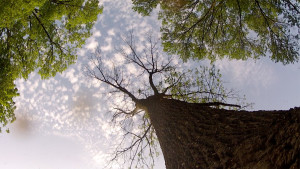
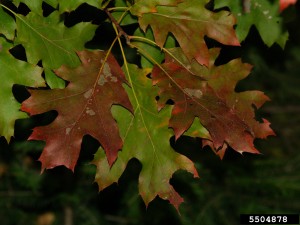
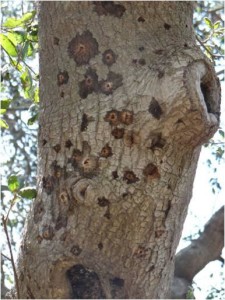 PSHB damage to coast live oak;
PSHB damage to coast live oak;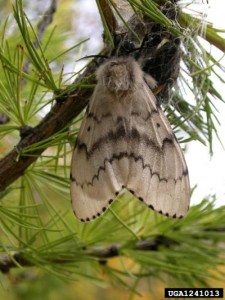
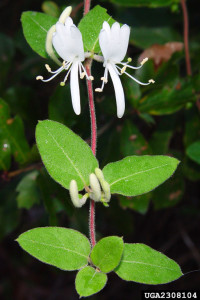
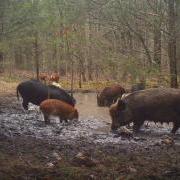 feral hogs in Missouri
feral hogs in Missouri